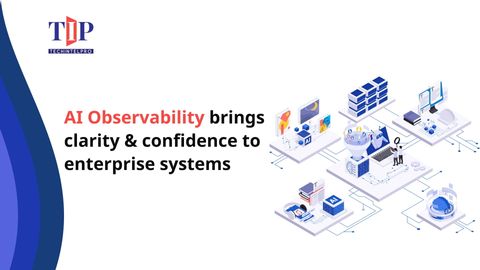Enterprises depend on AI more than ever, yet the real challenge isn’t adoption, it’s control. AI systems run on massive data pipelines, complex models, and distributed infrastructure. What’s needed is observability, a way to see inside AI systems and ensure they perform as expected.
Traditional monitoring tracks errors or downtime. It rarely explains why a problem occurs. That’s where AI observability comes in. It offers a clear view of data, model behavior, infrastructure, and AI decisions.
It helps enterprises detect issues early, remain compliant, and keep trust in AI systems. By combining observability with generative AI oversight and Zero Trust security, organizations can build AI that is reliable, safe, and high-performing.
Understanding AI Observability vs. Monitoring
AI observability and monitoring are closely related but distinct concepts. Monitoring focuses on key system metrics, including uptime, errors, and latency. It tells you when something goes wrong, but not why.
Observability goes deeper. It reveals how AI behaves, how decisions are made, how data flows, and how the system performs in real-world conditions. Observability can detect data drift, model bias, or performance issues before they affect business outcomes.
For example, consider a credit scoring AI. A change in input data causes the model to reject otherwise good applicants. Monitoring may show a spike in errors.
In short:
Monitoring = Detect problems.
Observability = Detect, understand, and fix problems.
Both are critical for enterprises. Monitoring ensures systems run. Observability ensures AI is reliable, trustworthy, compliant, and performing as intended.
Data, Model, and Infrastructure Observability
AI observability covers three critical layers: data, model, and infrastructure. Each layer plays a key role in ensuring AI systems are reliable, accurate, and high-performing.
Data Observability
AI models rely on accurate, consistent data. Issues like data drift, missing values, anomalies, or schema changes can degrade performance.
Observability detects these problems early, preventing garbage-in, garbage-out scenarios. Teams can use tools like WhyLabs, Great Expectations, or Monte Carlo to monitor pipelines and maintain high-quality inputs.
Model Observability
Observability tracks the performance, accuracy, and fairness of AI models. Key metrics include prediction drift, model degradation, and bias indicators. Generative AI outputs may show hallucinations, unsafe content, or biased responses.
Observability detects these issues before they affect decisions. Enterprises can intervene proactively, retraining models or adjusting thresholds to maintain trustworthy, explainable AI.
Infrastructure Observability
Observability ensures AI workloads run smoothly across infrastructure. Metrics such as GPU/CPU usage, memory, latency, and API performance are critical.
Enterprises in multi-cloud or hybrid environments rely on infrastructure observability to prevent bottlenecks, ensure responsiveness, and maintain scalability. Effective monitoring reduces downtime and improves efficiency.
Together, data, model, and infrastructure observability form a complete framework. Enterprises gain visibility, reliability, and control across the entire AI lifecycle. This comprehensive approach helps organizations trust AI outputs, maintain compliance, and optimize performance, even in complex environments.
Decision Traceability & Compliance
Decision traceability ensures that every output, recommendation, or action can be traced back to its inputs and the model’s reasoning. This visibility is critical for accountability, transparency, and trust.
Compliance is another key reason enterprises adopt decision traceability. Regulations require organizations to demonstrate that AI systems handle data responsibly. Decision traceability helps document AI behavior, making audits easier and reducing regulatory risk. Key regulations include:
-
GDPR – Ensuring personal data is processed fairly and lawfully.
-
HIPAA – Protecting sensitive health information in AI-driven healthcare applications.
-
SOC2 – Demonstrating controls over security, availability, and confidentiality.
-
Industry-specific standards – Compliance depending on the sector or use case.
Decision traceability adds a layer of observability. For instance, generative AI systems can produce undesirable outputs that are unsafe or exhibit some level of bias. This capability enables teams to respond more quickly.
Enterprises implement decision traceability through automated logging, structured output tracking, and explainable AI frameworks. At a high level, an organization's decision traceability enables trust. When combined with full-stack observability, this ensures your AI systems are trustworthy, explainable, and compliant, ultimately empowering organizations.
Security Alignment with Zero Trust Architecture
AI observability and decision traceability are most effective when combined with Zero Trust security principles.
Zero Trust Network Access (ZTNA) assumes no user or system is inherently trusted. Access is granted based on identity, context, and continuous verification, reducing the risk of unauthorized access to models, data, or infrastructure.
Even authorized users can act unexpectedly. Observability detects anomalous behavior such as unusual API calls, excessive resource usage, or unexpected data access. Combined with ZTNA, these insights let enterprises quickly isolate threats and protect critical AI assets.
Integrating observability with Zero Trust strengthens security across data pipelines, models, and infrastructure. Enterprises gain a proactive defense, continuously monitoring AI operations while enforcing access controls. Risks are detected, investigated, and mitigated in real time.
Ultimately, this combination creates a resilient, secure AI environment. Organizations can trust AI systems to operate reliably, safeguard sensitive information, and maintain compliance. It is essential for safely scaling AI across enterprise workflows.
Why AI Observability Matters Now
Paired with decision traceability, it makes outputs reliable and explainable. Observability across data, models, and infrastructure gives a clear view of AI performance, while traceability supports audits and compliance.
For enterprises, this isn’t just about metrics; it’s about trust. Strong observability ensures AI remains accurate, transparent, and scalable. Organizations that invest in it can detect issues early, reduce risks, and build AI systems that deliver real business value with confidence.


